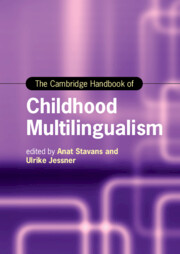Book contents
- The Cambridge Handbook of Childhood Multilingualism
- Cambridge Handbooks in Language and Linguistics
- The Cambridge Handbook of Childhood Multilingualism
- Copyright page
- Contents
- Figures
- Tables
- About the Editors
- Contributors
- Acknowledgments
- Multilingualism Is Not Bilingualism +1: An Introduction
- Part One Becoming and Being a Multilingual Child
- Part Two Cognition and Faculties in Multilinguals
- Part Three Family Language Policy
- Part Four Language(s) and Literacy of Multilingual Children through Schooling
- Part Five Socialization in Childhood Multilingualism
- Part Six Multilingual Children’s Landscape
- Subject Index
- Country Index
- Language Index
- References
Multilingualism Is Not Bilingualism +1: An Introduction
Published online by Cambridge University Press: 18 August 2022
- The Cambridge Handbook of Childhood Multilingualism
- Cambridge Handbooks in Language and Linguistics
- The Cambridge Handbook of Childhood Multilingualism
- Copyright page
- Contents
- Figures
- Tables
- About the Editors
- Contributors
- Acknowledgments
- Multilingualism Is Not Bilingualism +1: An Introduction
- Part One Becoming and Being a Multilingual Child
- Part Two Cognition and Faculties in Multilinguals
- Part Three Family Language Policy
- Part Four Language(s) and Literacy of Multilingual Children through Schooling
- Part Five Socialization in Childhood Multilingualism
- Part Six Multilingual Children’s Landscape
- Subject Index
- Country Index
- Language Index
- References
Summary
The Cambridge Handbook of Childhood Multilingualism provides a state-of-the art view of the intra- and interdisciplinarity in linguistics, psychology, sociology, and education through a kaleidoscope of languages, countries, scholars, and cultures. The volume provides: (1) understanding that for most children multilingualism is the linguistic reality in which they grow; (2) an analysis of the effect of languages flowing from different sources, at different times and in different forms, on the uniqueness of child multilingualism processing beyond mono/bilingualism; (3) insights into diversity in the socialization of multilingual children; (4) elaboration of the triangulation of childhood, parenthood, and schooling as natural multilingualism-cultivating conditions motivated by internal and external forces; (5) an integrative approach to multilingual children’s development where the child at the center is cradled by multilingualism and languages, and (6) a focus on multilingualism as a capacity independent from mono/bilingualism. The different language typologies, in different countries and different continents, gathered in this volume tease out what is universal to childhood multilingualism as an agent of “new linguistic realities.”
Keywords
- Type
- Chapter
- Information
- The Cambridge Handbook of Childhood Multilingualism , pp. 1 - 10Publisher: Cambridge University PressPrint publication year: 2022



